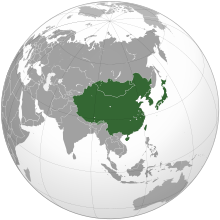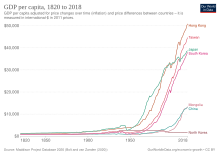 Global Information
Global InformationEconomy of East Asia information
 | |
| Statistics | |
|---|---|
| Population | 1.6 billion[1][2] |
| GDP |
|
GDP growth | 3.8% (2023 est.)[5] |
GDP per capita |
|
Inflation (CPI) | 2.2% (2023 est.)[8] |
| Unemployment | 4.2% (2021)[9] |
| Public finances | |
Government debt | 105.9% of GDP (2023 est.)[10] |
| Most numbers are from the International Monetary Fund. IMF East Asia Datasets All values, unless otherwise stated, are in US dollars. | |

The economy of East Asia comprises 1.6 billion people (20% of the world population) living in six different countries and regions. The region includes several of the world's largest and most prosperous economies: Taiwan, Japan, South Korea, China, Hong Kong, and Macau. It is home to some of the most economically dynamic places in the world,[11] being the site of some of the world's most extended modern economic booms, including the Taiwan miracle (1950–present) in Taiwan, Miracle on the Han River (1974–present) in South Korea, Japanese economic miracle (1950–1990) and the Chinese economic miracle (1983–2010) in China.[12][13]
East Asia's economic prominence has grown significantly in recent years, increasing its importance and influence in Asia and the world economy.[14][15] Recent developments have led to an expanding cosmopolitan middle class. East Asian countries are vital contributors to central global communications and trade networks, developing relations with other nations, including those of the Western world, making them a significant contributor to the global economy.[16] The region's economic success was referred to as "An East Asian Renaissance" by the World Bank in 2007.[17]
Since the early 20th century, East Asia has been home to two of the world's largest economies, with mainland China and Japan being the second and third largest, respectively.[18] Since the middle of the twentieth century, capitalism has been integrated with the Confucian nature of Oriental East Asia.[19] In defiance of an array of sociopolitical challenges, the East Asian economies turned into a modern economic miracle. Sustained efforts of veering East Asia into a capitalist direction have created remarkable outcomes in terms of resilience, dynamism, growth, and economic prosperity.[19] Even as late as the mid-twentieth century, East Asia remained nonindustrial, poverty-stricken, and torn by the ravages of World War II. Since the 1960s, Japan, South Korea, Taiwan, Hong Kong, Macau, and mainland China have achieved a modern economic takeoff leaving the economic rise of modern East Asia to become one of the most important economic success stories in modern world history.[20][21] Despite decades of setbacks and turmoil, East Asia is now one of the world's most economically prosperous and technologically advanced regions.[22]
Rapid modernisation, and a focus on high technology, have allowed East Asia to register rapid economic growth. The region is home to some of the world's most affluent nations and sees high standards of living. Japan saw rapid re-modernisation in the aftermath of World War II and, during the 1950s and early 1960s, increased its dominance in global trade, aided by its focus on innovation in automobiles and advanced consumer electronics, making it the world's third-largest economy after the United States and mainland China.[22] The rise of the Four Asian Tigers, including South Korea, Taiwan and Hong Kong, was characterised by unprecedented growth during the 1970s–1980s, placing themselves among the world's most prosperous and dynamic economies. Mainland China's continued growth and economic development, aided by its entry into the World Trade Organization in 2001, has made the country a significant contributor to the East Asian economy and increased its recognition as a major player in the world economy.[23] In addition, South Korea and Taiwan are among the largest manufacturers of consumer technology globally, while Hong Kong is widely recognized as a leading worldwide financial centre.
- ^ "World Population Prospects 2022". United Nations Department of Economic and Social Affairs, Population Division. Retrieved July 17, 2022.
- ^ "World Population Prospects 2022: Demographic indicators by region, subregion and country, annually for 1950-2100" (XSLX) ("Total Population, as of 1 July (thousands)"). United Nations Department of Economic and Social Affairs, Population Division. Retrieved July 17, 2022.
- ^ "GDP (Nominal), current prices". International Monetary Fund. Retrieved 5 November 2022.
- ^ "GDP (PPP), current prices". International Monetary Fund. Retrieved 5 November 2022.
- ^ International Monetary Fund (2022). "Real GDP growth". IMF Data Mapper. International Monetary Fund. Retrieved 5 November 2022.
- ^ International Monetary Fund (2022). "Nominal GDP per capita". IMF Data Mapper. International Monetary Fund. Retrieved 5 November 2022.
- ^ International Monetary Fund (2022). "GDP PPP per capita". IMF Data Mapper. International Monetary Fund. Retrieved 5 November 2022.
- ^ International Monetary Fund (2022). "Inflation rate, average consumer prices". IMF Data Mapper. International Monetary Fund. Retrieved 5 November 2022.
- ^ "Unemployment, total (% of total labor force)". World Bank. Archived from the original on 2020-09-24. Retrieved 2018-02-26.
- ^ International Monetary Fund (2022). "General government gross debt". IMF Data Mapper. International Monetary Fund. Retrieved 5 November 2022.
- ^ "The Political Economy Of China And East Asia". Retrieved 2018-01-22.
- ^ "East Asia in the 21st Century". Lumen. Archived from the original on 2020-09-24. Retrieved 2018-01-22.
- ^ Ng, Arden. "East Asia is the World's Largest Economy at $29.6 Trillion USD, Including 4 of the Top 25 Countries Globally". Blueback. Archived from the original on 2020-09-24. Retrieved 2018-02-26.
- ^ Van Vranken Hickey, Dennis (2001). The Armies of East Asia: China, Taiwan, Japan, and the Koreas. Lynne Rienner Publishing. p. 1. ISBN 978-1555879921.
- ^ Yoshimatsu, H. (2014). Comparing Institution-Building in East Asia: Power Politics, Governance, and Critical Junctures. Palgrave Macmillan. p. 1. ISBN 978-1137370549.
- ^ MacDonald, Scott B.; Lemco, Jonathan (2011). Asia's Rise in the 21st Century. Praeger (published October 20, 2011). pp. 2–3. ISBN 978-0313393709.
- ^ Gill, Indermit Singh; Kharas, Homi; et al. (2007), An East Asian Renaissance: Ideas for Economic Growth (PDF), Washington, DC: World Bank, ISBN 978-0-8213-6747-6, archived (PDF) from the original on 2016-03-04, retrieved 2015-08-30
- ^ Henckel, Timo (2017). Sustaining Development and Growth in East Asia. Routledge. p. 13. ISBN 978-1138108851.
- ^ a b Walter, Andrew; Zhang, Xiaoke (2014). East Asian Capitalism: Diversity, Continuity, and Change. Oxford University Press (published August 24, 2014). p. 3. ISBN 978-0198717553.
- ^ Yusuf, Shahid; Nabeshima, Kaoru (2009). Tiger Economies Under Threat: A Comparative Analysis of Malaysia's Industrial Prospects and Policy Options. World Bank (published October 1, 2009). pp. 1. ISBN 978-0821378809.
- ^ Holcombe, Charles (2010). A History of East Asia: From the Origins of Civilization to the Twenty-First Century. Cambridge University Press. p. 1. ISBN 978-0521731645.
- ^ a b Boone, Mark. "How East Asia Became An Economic Power" (PDF). Indian University Press. Archived (PDF) from the original on 2018-11-23. Retrieved 2018-01-22.
- ^ Smith, Heather. "The changing pattern of East Asia's growth". Australian Treasury. Archived from the original on 2020-09-24. Retrieved 2018-01-22.